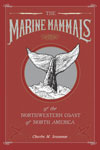|
||||||||||||||||||||||||||||||||||||||||
|
Charles Melville Scammon, a self-taught sailor, whaler, serviceman, and historian, couldn't help but humanize the loveable sea otter in his 1874 book The Marine Mammals of the North-Western Coast of North America. The mothers caress and suckle their offspring seemingly with much affection, fondling them with their fore paws—reclining, in their usual manner—and frequently uttering a plaintive sound, which may have given rise to the saying that "Sea Otters sing to quiet their young ones," and gives some credence to the suggestion that the human-like actions of the animal originated the story about mermaids. But when they are startled, they rise perpendicularly half their length out of the water; and if their quick, sharp eyes discern aught to cause alarm, the cubs are seized by the mouth, and both mother and offspring instantly disappear under water. Males and females are sometimes seen curled up in such shapelessness as to present no appearance of animal form. When in this posture they are said to be sleeping.The sea otter, which was almost extinct by 1831, was "rediscovered" off the Carmel coast in 1938, almost 100 years after Charles Scammon was born. –Contributed by Emily Elrod. |
|||||||||||||||||||||||||||||||||||||||
|
© 2000-2013 California Legacy Project, Santa Clara University English Department, Santa Clara University, 500 El Camino Real, Santa Clara, CA 95053.
For more information: Terry Beers, 408 554 4335, or . 



|
|

|







 The Marine Mammals of the North-Western Coast of North America: Described and Illustrated; Together With an Account of the American Whale-Fishery
The Marine Mammals of the North-Western Coast of North America: Described and Illustrated; Together With an Account of the American Whale-Fishery
